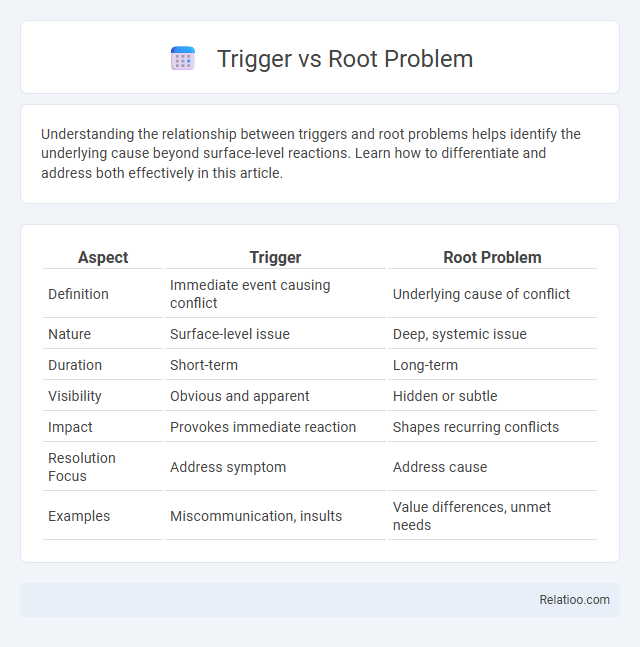Understanding the relationship between triggers and root problems helps identify the underlying cause beyond surface-level reactions. Learn how to differentiate and address both effectively in this article.
Table of Comparison
| Aspect | Trigger | Root Problem |
|---|---|---|
| Definition | Immediate event causing conflict | Underlying cause of conflict |
| Nature | Surface-level issue | Deep, systemic issue |
| Duration | Short-term | Long-term |
| Visibility | Obvious and apparent | Hidden or subtle |
| Impact | Provokes immediate reaction | Shapes recurring conflicts |
| Resolution Focus | Address symptom | Address cause |
| Examples | Miscommunication, insults | Value differences, unmet needs |
Understanding the Difference: Trigger vs Root Problem
Understanding the difference between a trigger and a root problem is essential for effective problem-solving. A trigger is an immediate event or condition that initiates an incident, while a root problem is the underlying cause that leads to repeated occurrences. Identifying the root problem enables long-term solutions, whereas addressing only the trigger provides temporary relief.
Why Identifying the Root Problem Matters
Identifying the root problem matters because it addresses the fundamental cause rather than just the trigger, preventing recurring issues and ineffective solutions. Your focus on the root problem ensures long-term improvements by targeting underlying factors that create triggers. Resolving the root problem transforms the entire system, making your solutions more sustainable and impactful.
Common Triggers: Symptoms, Not Causes
Common triggers often represent symptoms rather than the root problem, leading to repeated issues if only addressed superficially. Identifying the root problem requires deeper analysis beyond surface triggers to implement effective, long-term solutions. Your focus should be on uncovering underlying causes to prevent recurring triggers and improve overall outcomes.
How Triggers Mask Root Problems
Triggers often mask root problems by causing immediate reactions that divert attention from underlying issues, leading You to address symptoms rather than the actual cause. Root problems, hidden beneath surface triggers, require deeper analysis to identify the fundamental source of recurring challenges. Understanding the difference between triggers and root problems enhances problem-solving efficiency and fosters long-term solutions in personal or organizational contexts.
The Impact of Addressing Only Triggers
Addressing only triggers rather than root problems often results in temporary solutions that fail to eliminate the underlying causes of issues, leading to recurring challenges and inefficiencies. This approach can mask the symptom without improving overall system integrity or long-term outcomes. Organizations focusing on root problems instead experience sustained improvements and reduced resource expenditure by preventing issue recurrence.
Techniques for Uncovering Root Problems
Techniques for uncovering root problems involve systematic analysis methods such as the "5 Whys" and fishbone diagrams, which help identify the underlying causes beyond surface triggers. Root cause analysis requires gathering data from incidents and feedback to trace back to foundational issues rather than just addressing immediate symptoms. Your focus on these structured approaches empowers effective problem-solving by ensuring solutions target the core issues driving recurring problems.
Real-World Examples: Trigger vs Root Problem
In real-world scenarios, a trigger is an event that immediately activates a problem, such as a server crash caused by a sudden spike in traffic, while the root problem is the underlying issue, like outdated infrastructure unable to scale. For instance, a machine malfunction (trigger) may be caused by poor maintenance schedules or design flaws (root problems). Addressing root problems ensures sustainable solutions beyond managing recurring triggers.
Benefits of Root Cause Analysis
Root Cause Analysis (RCA) identifies the fundamental cause behind an issue rather than just addressing triggers or symptoms, leading to more effective and long-lasting solutions. By targeting the root problem, organizations can reduce recurring failures, improve operational efficiency, and enhance overall system reliability. RCA facilitates informed decision-making and resource allocation, minimizing downtime and driving continuous improvement.
Tools and Frameworks for Problem Diagnosis
Effective problem diagnosis in software development relies on distinguishing between triggers and root problems using specialized tools and frameworks. Root cause analysis frameworks like the Five Whys, Fishbone Diagram, and Ishikawa implemented in platforms such as Jira, Azure DevOps, or Miro enable pinpointing underlying issues beyond superficial triggers. Your use of these diagnostic tools ensures systematic identification and resolution, reducing recurrence and improving system reliability.
Steps to Move from Trigger to Root Problem Solutions
Identify the initial trigger by analyzing immediate causes and specific events that prompt a problem. Conduct root cause analysis techniques such as the 5 Whys or Fishbone Diagram to dig deeper beyond superficial triggers and uncover underlying systemic issues. Develop targeted interventions addressing the root problem to ensure long-term solutions rather than temporary fixes based solely on triggers.

Infographic: Trigger vs Root Problem
 relatioo.com
relatioo.com